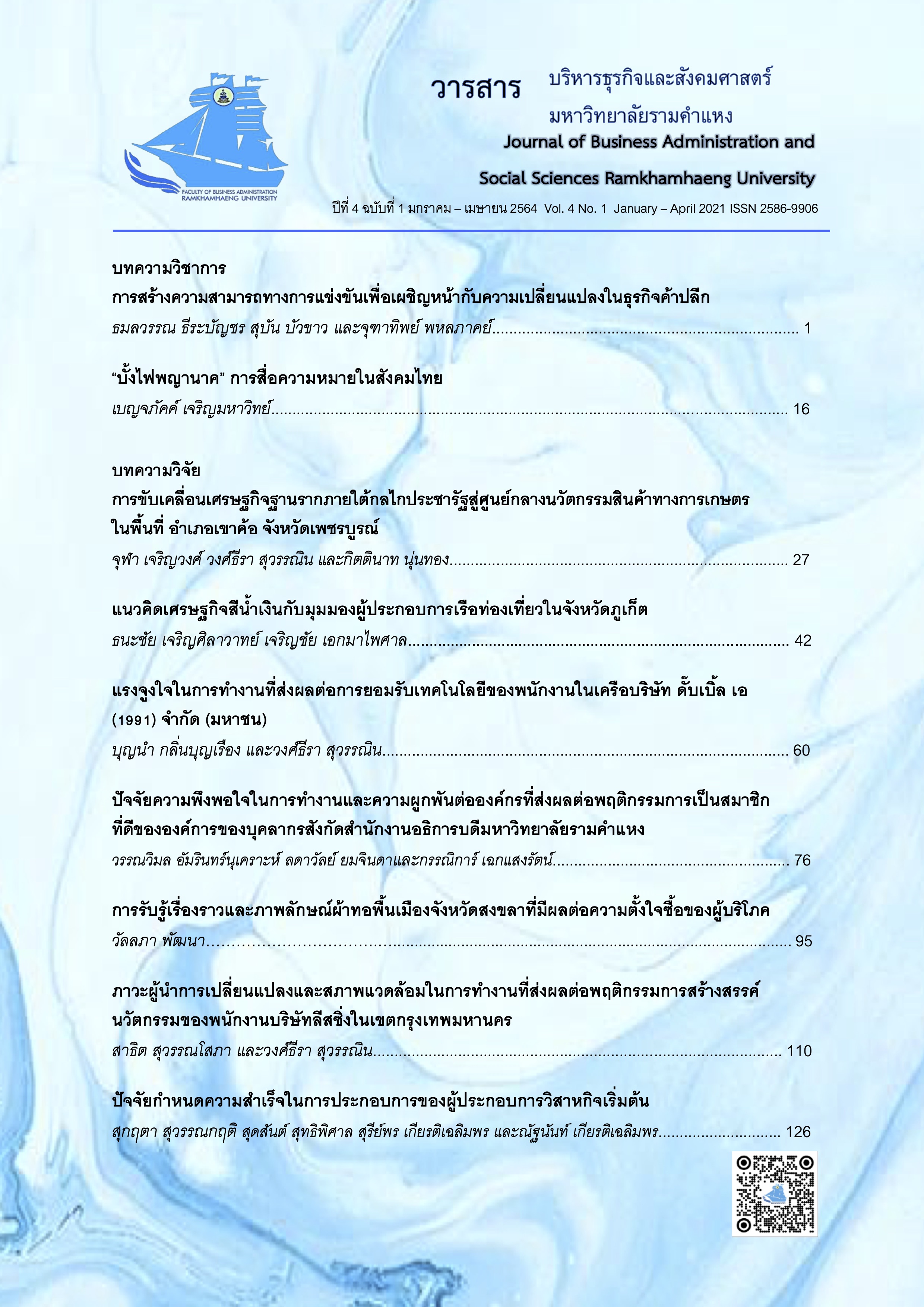Naga Fireballs “Bang Fai Phaya Nak”: The Interpretation in Thai Society
Main Article Content
Abstract
In this article, the researcher analyzes the interpretation of the symbol of naga fireballs, “bang fai phaya nak” as appeared in Thai society to indicate the directions of its meaning. The purpose is to identify ways of thinking, values, and worldviews of people in society of the symbol of “bang fai phaya nak”. The study was conducted using the technique of documentary research and in-depth interviews with five members of the sample population. Findings show that Thai society interprets the symbol of “bang fai phaya nak” in two dimensions as follows: 1) the aspect of science in the form of natural phenomena; and 2) the aspect of beliefs as the interpretation based on worldviews. The culture of beliefs is in religion, values, traditions, trust, and faith in the power of the serpent (naga), a sacred being as believed in Thai society. These beliefs have fostered human beings to be spiritually secured, safe in living a life, and living happily in society.
Article Details
เนื้อหาและข้อมูลในบทความที่ลงตีพิมพ์ในวารสารบริหารธุรกิจและสังคมศาสตร์ มหาวิทยาลัยรามคำแหง ถือเป็นข้อคิดเห็นและความรับผิดชอบของผู้เขียนบทความโดยตรง ซึ่งกองบรรณาธิการไม่จำเป็นต้องเห็นด้วย หรือร่วมรับผิดชอบใดๆ
บทความ ข้อมูล เนื้อหา รูปภาพ ฯลฯ ที่ได้รับการตีพิมพ์ในวารสารบริหารธุรกิจและสังคมศาสตร์ มหาวิทยาลัยรามคำแหง ถือเป็นลิขสิทธิ์ของวารสารบริหารธุรกิจและสังคมศาสตร์ มหาวิทยาลัยรามคำแหง หากบุคคลหรือหน่วยงานใดต้องการนำบทความทั้งหมดหรือส่วนหนึ่งส่วนใดไปเผยแพร่ต่อ หรือเพื่อกระทำการใดๆ จะต้องได้รับอนุญาตเป็นลายลักษณ์อักษรจากวารสารบริหารธุรกิจและสังคมศาสตร์ มหาวิทยาลัยรามคำแหง ก่อนเท่านั้น
References
กรมศิลปากร. (2483). อุรังคธาตุ (ตำนานพระธาตุพนม). กรุงเทพฯ: ที่ระลึกงานพระราชทานเพลิงศพ อ.ต. หลวงประชุมบรรณสาร (พิณ เดชะคุปต์).
จิตรกร เอมพันธ์. (2545). พญานาค เจ้าแห่งแม่น้ำโขง: พิธีกรรมกับระบบความเชื่อพื้นบ้านแห่งวัฒนธรรมอีสาน. วิทยานิพนธ์มานุษยวิทยามหาบัณฑิต, จุฬาลงกรณ์มหาวิทยาลัย.
ชาญ เกลี้ยงพิบูลย์. (2540). บั้งไฟพญานาคกับการควบคุมทางสังคม: ศึกษากรณีเฉพาะกิ่งอำเภอรัตนวาปี จังหวัดหนองคาย. สารนิพนธ์สังคมสงเคราะห์ศาสตรมหาบัณฑิต, มหาวิทยาลัยธรรมศาสตร์
ไชยรัตน์ เจริญสินโอฬาร. (2545). สัญวิทยา โครงสร้างนิยม หลังโครงสร้างนิยมกับการศึกษารัฐศาสตร์. กรุงเทพ: วิภาษา.
บุญยงค์ เกศเทศ. (2557). ผีวิถีคน ความเชื่อและการพึ่งพาระหว่างคนกับผี. มหาสารคาม: กากะเยีย.
ปิยธิดา ตรีเดช. (2546). ความคิดเห็นของผู้เข้าร่วมสัมมนาเชิงวิชาการเรื่องปรากฏการณ์บั้งไฟพญานาค.รัฐสภาสาร, 51(8), 73-81.
ผู้จัดการออนไลน์. (2562). พิสูจน์ปรากฏการณ์ “บั้งไฟพญานาค”กับหลักการวิทยาศาสตร์. สืบค้นเมื่อ
มีนาคม 2563 จาก http://www.neutron.rmutphysics.com/sciencenews/index.php?
option=com_content&task=view&id=670&Itemid=0
มนัส กนกศิลป์ และคณะ. (2555). ปะทะ 2 ความคิด “บั้งไฟพญานาค” เกิดขึ้นเองหรือคนทำ.สืบค้นเมื่อ
มกราคม 2563 จาก http://www.mgronline.com/science/detail/955000144490
มหาบุญมี เทพสีเมือง. (2554). หินดาวเล่านิทานเรื่องพญาแถน. กรุงเทพฯ: สุขภาพใจ.
วาสนา ศรีรักษ์. (2548, 29 ตุลาคม). บั้งไฟพญานาค ตำนานแห่งความศรัทธา. หนังสือพิมพ์สยามรัฐ.
วิเชียร นามการ. (2554). การศึกษาอิทธิพลความเชื่อเรื่องพญานาคที่มีผลต่อสังคมไทยในปัจจุบัน. วิทยานิพนธ์ปริญญาพุทธศาสตรมหาบัณฑิต, มหาจุฬาลงกรณ์ราชวิทยาลัย.
สมบัติ พลายน้อย. (2554). ครุฑยุดนาค ตำนานว่าด้วยการกำเนิดแห่ง “ครุฑ” และ “พญานาค”. กรุงเทพฯ: พิมพ์คำ.
อคิน ระพิพัฒน์. (2551). วัฒนธรรมคือความหมาย: ทฤษฏีทางวิชาการของคลิฟฟอร์ด เกียร์ซ. กรุงเทพ: ศูนย์มานุษยวิทยาสิรินธร (องค์การมหาชน).
Durkheim, E. (1976). The Elementary Forms of Religious Life. (Translated by J.W. Swain) (2nded.) London: Allen&Unwin.
MGR online. (2547, 28 ตุลาคม). พิสูจน์ปรากฏการณ์ “บั้งไฟพญานาค” กับหลักวิทยาศาสตร์, สืบค้นเมื่อ
มีนาคม 2563 จาก https://mgronline.com/science/detail/9470000073245


